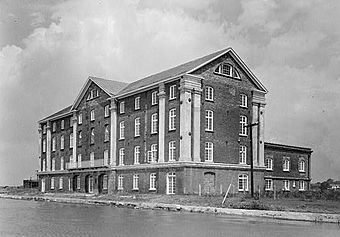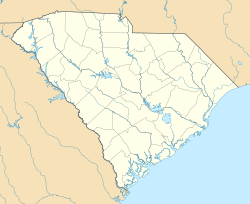West Point Rice Mill facts for kids
Quick facts for kids |
|
|
West Point Rice Mill
|
|

West Point Rice Mill in 1940
|
|
| Location | City Marina 17 Lockwood Dr., Charleston, South Carolina |
|---|---|
| Built | 1861 |
| Architect | Delano and Aldrich Works Progress Administration (1930s renovations) |
| NRHP reference No. | 94001569 |
| Added to NRHP | January 20, 1995 |
The West Point Rice Mill is an old building in Charleston, South Carolina. It used to be a factory where rice was processed. You can find it at the City Marina, located at 17 Lockwood Drive. In the 1800s, the West Point Mill was one of three big rice mills in Charleston. This building was built in 1861. It replaced an earlier rice mill that had burned down the year before. The West Point Rice Mill was added to the National Register of Historic Places on January 20, 1995. This means it's an important historical site.
Contents
The Story of West Point Rice Mill
Early Days: Building a Mill
In 1840, a man named Jonathan Lucas III built a large rice mill. It was made of brick and had four stories. This mill used steam power to process rice. It was located right on the Ashley River. Sadly, this first mill caught fire and burned down on November 20, 1860.
Building a new mill started very quickly. Even though there was a Union blockade during the Civil War, the new mill was ready to operate by late 1863. When the Union Army took over Charleston in 1865, the mill was used to give out food.
After the Civil War: Changes and Challenges
After the Civil War ended, the mill started working again. It even made more rice than before. But in 1886, a big earthquake hit Charleston. The mill's brick walls were damaged, and parts of its roof fell down. Before the 1920s, the entire roof was replaced. Only the main support beams, called kingposts and trusses, were kept.
By 1890, the three rice mills in Charleston produced over 97,000 barrels of rice. However, farmers in the western United States started growing a lot of rice. This created strong competition. Also, several hurricanes hit South Carolina. Because of these reasons, rice production in South Carolina began to decrease.
In 1888, the West Point Mill Company bought a part of another mill called Chisolm's Mill. Then, in 1894, West Point Mill and Bennett's Mill joined together. They bought Chisolm's Mill completely and closed it down. Rice production kept falling. The West Point Mill finally closed in 1920. The company then started selling its parts and property. Around 1925, the mill's large steam engine was sold to the Henry Ford Museum. In 1926, the City of Charleston bought the mill's land.
In 1930, the U.S. Post Office wanted to build a seaplane base at the site. They planned to use it for mail delivery. This idea never fully happened. However, it made people think about using the site as a seaplane terminal.
In 1933, the Civil Works Administration began building the Municipal Yacht Basin there. Later that year, the mill building was rented out to the American Bagging Company. They used it as a storage place for jute, which is a fiber used to make bags.
The City of Charleston kept looking for ways to use the building as a seaplane terminal. In 1937, the Works Progress Administration started work to turn the mill into an air terminal. This was named the James F. Byrnes air terminal. A famous airline, Pan American World Airways, hired architects to design a passenger station. They fixed up the outside of the building and the first two floors.
When World War II started in Europe, flights across the Atlantic Ocean stopped. The City of Charleston tried to get a naval seaplane base, but it went to Jacksonville, Florida, instead. The building was then used by the Charleston District of the Civilian Conservation Corps. In 1941, the U.S. Navy took over the building. They used it for managing patrols along the coast. In 1946, it became the main office for a Navy mine craft base. The U.S. Navy used the building through the 1950s. After that, it was given to the U.S. Army Corps of Engineers.
Recent Times: Restoration and New Life
From 1966 to about 1986, the Trident Chamber of Commerce was located in the building. There were also some other businesses renting space. After that, the building was empty again.
In the fall of 1989, a fire caused a lot of damage to a part of the building. Then, Hurricane Hugo hit and damaged the roof. After repairs, the building was rented to the Bennett-Hofford Company. This company spent $3 million to fix up the building. This happened before it was added to the National Register of Historic Places. Since then, many offices and restaurants have been in the building. The restoration work even won an award in 1995 from the Preservation Society of Charleston.
What Does the Mill Look Like?
Original Design and Early Changes
The main part of the original building is 142 feet (about 43 meters) long. It is 42 feet (about 13 meters) wide. It has a gabled roof, which means the roof slopes down on two sides. Even though it was the biggest rice mill in Charleston, it didn't have as many fancy details as the other two mills.
The building is made of brick laid in a pattern called Flemish bond. It has three and a half stories above the ground. On the side facing the Ashley River, there are eleven sections, called bays. The middle three bays stick out a little bit. The building has a Palladian style. This means it has columns, called pilasters, that are flat against the wall. These pilasters mark the three bays of the main entrance on the river side. There are also pilasters on the sides of the last bay on both the east and west sides. Pairs of pilasters are at the ends of the north and south sides.
Two wings extend from the east side of the building. Each wing is 36 feet (about 11 meters) long and 26 feet (about 8 meters) wide. The mill used to have two tall, eight-sided smokestacks on its east side.
After the 1886 earthquake, special earthquake bolts were put in the building. You can still see these bolts on the building and its wings today. The damaged gables, which are the triangular parts of the wall under the roof, were patched up with roofing materials.
Modern Updates and Repairs
The renovations that started in 1937 mostly changed the inside of the building. The outside changes were small. The smokestacks were removed. A new entrance was built on the east side. The ground floor was rebuilt with a concrete base. The brickwork on the gables was fixed, but the new bricks didn't match the old ones perfectly. Half-moon shaped windows were put in the gables. Round windows, called oculus windows, were put in some window openings on the third floor of the central gable on the west side. Stone sills were added to the first-floor windows. Only the first and second floors were fully completed at that time.
After 1946, a lobby was built on the first floor in front of the central bays on the west side. This lobby had a balcony on its roof with an iron railing. After the 1989 fire, the balcony railing was removed. The west side of the building was rebuilt with three arched openings.
An elevator was added to the east side entrance in the 1960s.
After Hurricane Hugo caused damage, the roof was replaced with copper. Four small, sloped windows, called shed dormers, were added to the west side of the roof.
Images for kids




